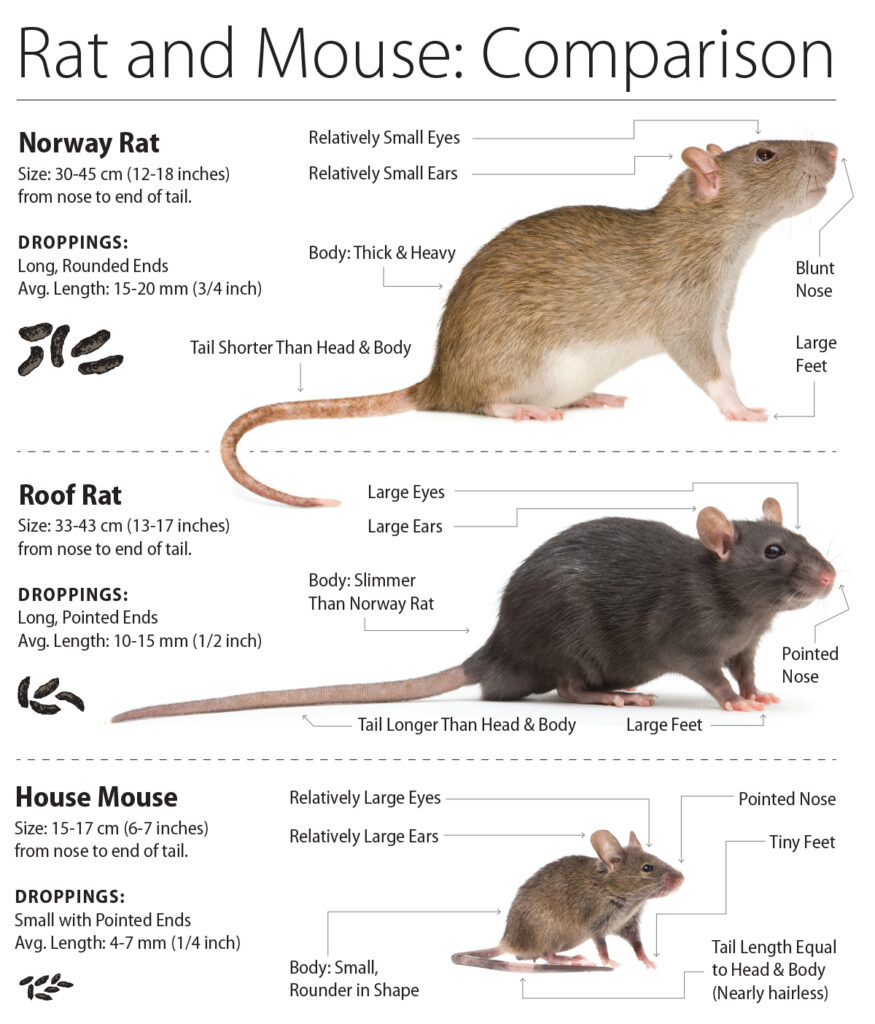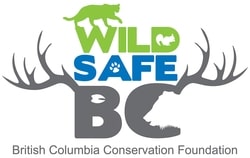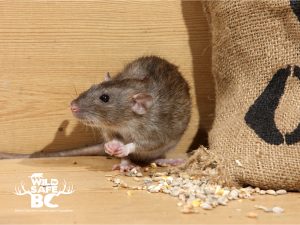Rats
Rat Snapshot
There are two types of rats in BC: the Norway rat (Rattus norvegicus) and the roof rat (Rattus rattus). Rats are not native to BC and were introduced via boat traffic in the mid-1800s. They tend to thrive only in urban areas where food is abundant or where winters are mild. However, rats have now expanded their range as far east as the Kootenays. Rats are prodigious breeders and a pair of rats could theoretically produce over 900 offspring within a single year.
Rats are rodents with very sharp teeth that can even chew through metal. They can cause significant damage to buildings, electrical wiring, and crops. They are also a threat to native wildlife and have decimated populations of ground-nesting birds. Rats will also prey on small livestock such as chickens, especially their eggs and chicks, and can contaminate feed with their urine and feces. Rats are also known to carry and spread a variety of diseases that can impact human health.
Rats require food, water and shelter. Controlling food and water sources, limiting denning areas and using exclusion techniques are key to keeping rats in check. Trapping rats may be required once access to habitat needs have been addressed. Rats are not a species that the Conservation Officer Service deals with. Contact a local, reputable pest control agent if you need assistance with removing rats. If trapping rats yourself, avoid using techniques that cause undue suffering or poisons that can be dangerous to pets, children and other wildlife.
Wild Rat Facts
- Rats were introduced to BC in the mid-1800s and there are two species: the Norway rat and the roof rat
- Rats can grow up to 50 cm in length with about half of that being a tail that is devoid of hair
- Owls, hawks, foxes, coyotes, and weasels prey upon rats; snakes eat immature rats
- Using poisons to kill rats may also result in their predators becoming ill or dying
- Rats are prodigious breeders and a pair of rats could theoretically produce over 900 offspring within a single year
- Rats do not hibernate and if conditions are favourable, can reproduce year-round
- Rats are short-lived and usually only survive a little over a year outside of captivity
- Rats are omnivores (meaning they eat both meat and plant materials), but focus primarily on vegetation, including grains, fruits and vegetables
- Rats can swim and some will even dive for mussels or small fish.
Identification
There are two types of rats in BC: the Norway rat (Rattus norvegicus) and the roof/black rat (Rattus rattus). Both have a long tail that is mostly devoid of hair. Norway rats tend to be more stout, greyish-brown in colour, and can weigh up to 0.5 kg with a tail shorter than the length of its body (including the head). Norway rat droppings are dark with rounded ends and are about 15-20 mm long.
The roof rat tends to have a darker coat with a pale underside. It tends to be slimmer than the Norway rat with a tail longer than its body. Its ears are also proportionately larger. Roof rat droppings are 10-15 mm and have pointed ends. In comparison, the introduced house mouse (Mus musculus) and native deer mice (Peromyscus spp.) droppings are only 6 mm long with pointed ends. Mice are small rodents less than 30 g and can squeeze through cracks just over 1 cm wide.
While the native bushy-tailed woodrat (Neotoma cinerea), also called a packrat, is a rodent, it is not a true rat.
Biology
Rats are rodents with very sharp teeth and are excellent diggers. Rat populations, once established, can increase exponentially in a very short period of time. They are prodigious breeders and a pair of rats could theoretically produce over 900 offspring within a single year. Rats are short lived and usually only survive a little over a year outside of captivity.
Owls, hawks, foxes, coyotes, and weasels prey upon rats; snakes eat immature rats.
Rats are omnivores (meaning they eat both meat and plant materials), but focus primarily on vegetation, including grains, fruits and vegetables.
Behaviour
Roof rats tend to seek shelter at higher levels such as attics while Norway rats tend to live closer to ground level. Rats tend to be fearful and prefer to move under cover. They are more active at night (nocturnal). They will have a nest or den from which they will leave to go on nightly foraging expeditions. Normally, rats will forage within 100 m of their den but can travel longer distances if food is scarce. Rats are very adaptable when it comes to choosing a food supply and learn from their neighbour's specific foraging techniques. Rats can swim and some will even dive for food like mussels and small fish.
Range and Habitat
Rats are not native to BC and were introduced via boat traffic in the mid-1800s. Once limited to coastal BC communities, Norway and Black Rats are well established in B.C.’s Lower Mainland and coastal islands. More recently they have become established in B.C.’s interior, including throughout the Okanagan Valley (Vernon, Kelowna, Penticton, Osoyoos), Kamloops, the Shuswap area, Revelstoke, and the Kootenay region (Nelson, Castlegar, New Denver, Creston). Rats may be living in more northerly locations but have yet to be reported.
Rat Safety
Rats should never be handled directly as they have very sharp teeth and a bite or scratch from a rat needs to be checked out immediately by a professional. Children should be taught not to approach any wildlife; serious bites and scratches may result from an encounter with a rat.
Rats (and mice) can carry a wide variety of diseases that can be transmitted to humans either through direct contact (bites or scratches) or via indirect means such as contamination by urine or feces. Always address rodent infestations in your home and use precautions if you find droppings in sheds and outbuildings. Never handle dead wildlife with bare hands.
Special note: Hantavirus Pulmonary Syndrome is associated with the inhalation of wild deer mouse droppings but has not been associated with the common house mouse. Refer to the section on “Cleaning Areas Where Rodents Have Been” on the Growing in Wildlife Country Page.
Conflict Reduction with Rats
Rats are not native to BC and tend to thrive only in urban areas or areas where food is abundant and winters are mild. However their range continues to expand. Rats can cause significant damage to gardens, buildings, crops, and livestock in their search for food and denning sites. Rats cause damage both from feeding on crops but also from gnawing through structures, including electrical wires.
It is in a home owner’s best interest to keep a rat population from establishing itself in the first place; prevention is easier than eradication. Controlling food sources and limiting denning areas are key to keeping rats in check - trapping is, at best, a stop-gap measure. For advice of managing rats when raising livestock, refer to Reducing Conflict Where We Grow.
Managing Attractants
Rats cannot survive without food, water and shelter. If you have rats on your property there is a good chance your neighbour does as well. Rat issues need to be addressed on a block-wide basis. Rat eradication from a community is extremely challenging once established. Trapping rats may help but the problem will likely persist if attractants are not addressed.
- Keep all garbage securely stored until the day of collection. Garbage should be stored in a secure container which should be cleaned on a regular basis.
- Feed pets indoors, or if fed outdoors, bring in any feed that is not immediately eaten by your pets. Rats will quickly target any type of pet food left out.
- Take bird feeders down at night and feed only during winter months. Bird feeders attract a wide variety of wildlife and rats can climb along wires, ropes or steel posts. Be sure to clean up ALL spilled seed under the bird feeder. As rats are nocturnal, taking the feeder in at night will minimize the potential for rats accessing the feed.
- Ideally you will use a rodent or bear-resistant composter, however lacking that, manage your compost properly and turn regularly and right to the bottom to ensure that rats cannot nest underneath the compost. Line the bottom of your compost with wire mesh to exclude rats. Learn more at Reducing Conflict Where We Grow
- Clean up all fallen fruits and nuts from trees.
- Store dry food and animal feed in rodent-proof containers such as glass or metal.
- Repair any leaky plumbing or garden hoses.
To see rats in action, watch these WildSafeBC videos of a roof rat eating a tomato at night and rats feeding on bird seed.
Remove Cover and Shelter
- Block all openings that are greater than 6 mm to exclude mice and rats with durable materials.
- Use 6 mm (1/4”) wire mesh for vents where air flow is required.
- Repair cracks in foundations or footings.
- Remove unnecessary wood piles, heavy brush, unused sheds or equipment.
- Keep the perimeter of your building clear of stored lumber or plantings.
- Store lumber and firewood on stands 30 to 45 cm off the ground.
- Prune overhead branches that may provide access to your balcony, roof and/or attic.
- Build sheds on concrete foundations.
- Do not store old cars or furniture outside.
To see rats in action, watch these WildSafeBC videos of a rat using wood piles for cover.
Trapping Rats
Trapping rats may be required once access to food, water and shelter has been addressed. Rats are not a species that the Conservation Officer Service deals with. Contact a local, reputable pest control agent if you need assistance with removing rats. If you plan to remove rats yourself, avoid using methods that result in unnecessary suffering or that might impact native species. If using snap traps, ensure that they are strong enough to kill quickly and that they are inaccessible by pets, wildlife and children. Remember to never handle dead animals with bare hands. Refer to guidelines and best practices provided by the Province of British Columbia for more suggestions.
Poison bait should be avoided as poisoned rats may crawl away and die in inaccessible areas and leave unpleasant odours. They can also lead to illness or death of native species that prey on rats. Poisons can also accidentally harm pets, wildlife or even children.
Cleaning Areas Where Rodents Have Been
This advice is excerpted from HealthLinkBC and includes techniques for cleaning up rodent droppings which may include deer mouse droppings that can cause Hantavirus Pulmonary Syndrome:
- “Prevent stirring up dust when you are cleaning areas where mice have lived. This includes ventilating any enclosed area for 30 minutes and wetting down the area with household disinfectant before you start. Most general purpose disinfectants and household detergents are effective. A mixture of one part bleach and 10 parts water can also be used. Pour mixture carefully onto the area to avoid disturbing any virus present—do not use a sprayer.
- Wipe up droppings, nesting materials and other waste with a paper towel and place in a plastic garbage bag. Do not sweep or vacuum.
- Double bag the contents, seal the bags, and then bury, burn, or place the bags in the trash, according to local bylaws.
- Clean floors, carpets, clothing and bedding, and disinfect counter-tops, cabinets and drawers that have been in contact with mice.
- Wash rubber gloves with disinfectant or soap and water before removing them. Wash your hands with soap and water after removing gloves.
- During clean-up, make sure to wear an appropriate, well-fitting filter mask, rubber gloves and goggles. For more information on appropriate masks contact your local public health unit or environmental health officer.”
Prevent the Spread and Report
Do not transport rats or release them into the wild. If you observe a rat in an area already known to have populations, you can document your sighting and contribute distribution information to iNaturalist. If you observe a rat outside of the currently know distribution area, please report your sightings to the Province at www.gov.bc.ca/invasive-species.
Rat Resources
- iNaturalist - View reports of rats made by the public and contribute your own sightings
- Province of British Columbia - Managing rats and mice
Rat Snapshot
There are two types of rats in BC: the Norway rat (Rattus norvegicus) and the roof rat (Rattus rattus). Rats are not native to BC and were introduced via boat traffic in the mid-1800s. They tend to thrive only in urban areas where food is abundant or where winters are mild. However, rats have now expanded their range as far east as the Kootenays. Rats are prodigious breeders and a pair of rats could theoretically produce over 900 offspring within a single year.
Rats are rodents with very sharp teeth that can even chew through metal. They can cause significant damage to buildings, electrical wiring, and crops. They are also a threat to native wildlife and have decimated populations of ground-nesting birds. Rats will also prey on small livestock such as chickens, especially their eggs and chicks, and can contaminate feed with their urine and feces. Rats are also known to carry and spread a variety of diseases that can impact human health.
Rats require food, water and shelter. Controlling food and water sources, limiting denning areas and using exclusion techniques are key to keeping rats in check. Trapping rats may be required once access to habitat needs have been addressed. Rats are not a species that the Conservation Officer Service deals with. Contact a local, reputable pest control agent if you need assistance with removing rats. If trapping rats yourself, avoid using techniques that cause undue suffering or poisons that can be dangerous to pets, children and other wildlife.
Wild Rat Facts
- Rats were introduced to BC in the mid-1800s and there are two species: the Norway rat and the roof rat
- Rats can grow up to 50 cm in length with about half of that being a tail that is devoid of hair
- Owls, hawks, foxes, coyotes, and weasels prey upon rats; snakes eat immature rats
- Using poisons to kill rats may also result in their predators becoming ill or dying
- Rats are prodigious breeders and a pair of rats could theoretically produce over 900 offspring within a single year
- Rats do not hibernate and if conditions are favourable, can reproduce year-round
- Rats are short-lived and usually only survive a little over a year outside of captivity
- Rats are omnivores (meaning they eat both meat and plant materials), but focus primarily on vegetation, including grains, fruits and vegetables
- Rats can swim and some will even dive for mussels or small fish.
Identification
There are two types of rats in BC: the Norway rat (Rattus norvegicus) and the roof/black rat (Rattus rattus). Both have a long tail that is mostly devoid of hair. Norway rats tend to be more stout, greyish-brown in colour, and can weigh up to 0.5 kg with a tail shorter than the length of its body (including the head). Norway rat droppings are dark with rounded ends and are about 15-20 mm long.
The roof rat tends to have a darker coat with a pale underside. It tends to be slimmer than the Norway rat with a tail longer than its body. Its ears are also proportionately larger. Roof rat droppings are 10-15 mm and have pointed ends. In comparison, the introduced house mouse (Mus musculus) and native deer mice (Peromyscus spp.) droppings are only 6 mm long with pointed ends. Mice are small rodents less than 30 g and can squeeze through cracks just over 1 cm wide.
While the native bushy-tailed woodrat (Neotoma cinerea), also called a packrat, is a rodent, it is not a true rat.
Biology
Rats are rodents with very sharp teeth and are excellent diggers. Rat populations, once established, can increase exponentially in a very short period of time. They are prodigious breeders and a pair of rats could theoretically produce over 900 offspring within a single year. Rats are short lived and usually only survive a little over a year outside of captivity.
Owls, hawks, foxes, coyotes, and weasels prey upon rats; snakes eat immature rats.
Rats are omnivores (meaning they eat both meat and plant materials), but focus primarily on vegetation, including grains, fruits and vegetables.
Behaviour
Roof rats tend to seek shelter at higher levels such as attics while Norway rats tend to live closer to ground level. Rats tend to be fearful and prefer to move under cover. They are more active at night (nocturnal). They will have a nest or den from which they will leave to go on nightly foraging expeditions. Normally, rats will forage within 100 m of their den but can travel longer distances if food is scarce. Rats are very adaptable when it comes to choosing a food supply and learn from their neighbour's specific foraging techniques. Rats can swim and some will even dive for food like mussels and small fish.
Range and Habitat
Rats are not native to BC and were introduced via boat traffic in the mid-1800s. Once limited to coastal BC communities, Norway and Black Rats are well established in B.C.’s Lower Mainland and coastal islands. More recently they have become established in B.C.’s interior, including throughout the Okanagan Valley (Vernon, Kelowna, Penticton, Osoyoos), Kamloops, the Shuswap area, Revelstoke, and the Kootenay region (Nelson, Castlegar, New Denver, Creston). Rats may be living in more northerly locations but have yet to be reported.
Rat Safety
Rats should never be handled directly as they have very sharp teeth and a bite or scratch from a rat needs to be checked out immediately by a professional. Children should be taught not to approach any wildlife; serious bites and scratches may result from an encounter with a rat.
Rats (and mice) can carry a wide variety of diseases that can be transmitted to humans either through direct contact (bites or scratches) or via indirect means such as contamination by urine or feces. Always address rodent infestations in your home and use precautions if you find droppings in sheds and outbuildings. Never handle dead wildlife with bare hands.
Special note: Hantavirus Pulmonary Syndrome is associated with the inhalation of wild deer mouse droppings but has not been associated with the common house mouse. Refer to the section on “Cleaning Areas Where Rodents Have Been” on the Growing in Wildlife Country Page.
Conflict Reduction with Rats
Rats are not native to BC and tend to thrive only in urban areas or areas where food is abundant and winters are mild. However their range continues to expand. Rats can cause significant damage to gardens, buildings, crops, and livestock in their search for food and denning sites. Rats cause damage both from feeding on crops but also from gnawing through structures, including electrical wires.
It is in a home owner’s best interest to keep a rat population from establishing itself in the first place; prevention is easier than eradication. Controlling food sources and limiting denning areas are key to keeping rats in check - trapping is, at best, a stop-gap measure. For advice of managing rats when raising livestock, refer to Reducing Conflict Where We Grow.
Managing Attractants
Rats cannot survive without food, water and shelter. If you have rats on your property there is a good chance your neighbour does as well. Rat issues need to be addressed on a block-wide basis. Rat eradication from a community is extremely challenging once established. Trapping rats may help but the problem will likely persist if attractants are not addressed.
- Keep all garbage securely stored until the day of collection. Garbage should be stored in a secure container which should be cleaned on a regular basis.
- Feed pets indoors, or if fed outdoors, bring in any feed that is not immediately eaten by your pets. Rats will quickly target any type of pet food left out.
- Take bird feeders down at night and feed only during winter months. Bird feeders attract a wide variety of wildlife and rats can climb along wires, ropes or steel posts. Be sure to clean up ALL spilled seed under the bird feeder. As rats are nocturnal, taking the feeder in at night will minimize the potential for rats accessing the feed.
- Ideally you will use a rodent or bear-resistant composter, however lacking that, manage your compost properly and turn regularly and right to the bottom to ensure that rats cannot nest underneath the compost. Line the bottom of your compost with wire mesh to exclude rats. Learn more at Reducing Conflict Where We Grow
- Clean up all fallen fruits and nuts from trees.
- Store dry food and animal feed in rodent-proof containers such as glass or metal.
- Repair any leaky plumbing or garden hoses.
To see rats in action, watch these WildSafeBC videos of a roof rat eating a tomato at night and rats feeding on bird seed.
Remove Cover and Shelter
- Block all openings that are greater than 6 mm to exclude mice and rats with durable materials.
- Use 6 mm (1/4”) wire mesh for vents where air flow is required.
- Repair cracks in foundations or footings.
- Remove unnecessary wood piles, heavy brush, unused sheds or equipment.
- Keep the perimeter of your building clear of stored lumber or plantings.
- Store lumber and firewood on stands 30 to 45 cm off the ground.
- Prune overhead branches that may provide access to your balcony, roof and/or attic.
- Build sheds on concrete foundations.
- Do not store old cars or furniture outside.
To see rats in action, watch these WildSafeBC videos of a rat using wood piles for cover.
Trapping Rats
Trapping rats may be required once access to food, water and shelter has been addressed. Rats are not a species that the Conservation Officer Service deals with. Contact a local, reputable pest control agent if you need assistance with removing rats. If you plan to remove rats yourself, avoid using methods that result in unnecessary suffering or that might impact native species. If using snap traps, ensure that they are strong enough to kill quickly and that they are inaccessible by pets, wildlife and children. Remember to never handle dead animals with bare hands. Refer to guidelines and best practices provided by the Province of British Columbia for more suggestions.
Poison bait should be avoided as poisoned rats may crawl away and die in inaccessible areas and leave unpleasant odours. They can also lead to illness or death of native species that prey on rats. Poisons can also accidentally harm pets, wildlife or even children.
Cleaning Areas Where Rodents Have Been
This advice is excerpted from HealthLinkBC and includes techniques for cleaning up rodent droppings which may include deer mouse droppings that can cause Hantavirus Pulmonary Syndrome:
- “Prevent stirring up dust when you are cleaning areas where mice have lived. This includes ventilating any enclosed area for 30 minutes and wetting down the area with household disinfectant before you start. Most general purpose disinfectants and household detergents are effective. A mixture of one part bleach and 10 parts water can also be used. Pour mixture carefully onto the area to avoid disturbing any virus present—do not use a sprayer.
- Wipe up droppings, nesting materials and other waste with a paper towel and place in a plastic garbage bag. Do not sweep or vacuum.
- Double bag the contents, seal the bags, and then bury, burn, or place the bags in the trash, according to local bylaws.
- Clean floors, carpets, clothing and bedding, and disinfect counter-tops, cabinets and drawers that have been in contact with mice.
- Wash rubber gloves with disinfectant or soap and water before removing them. Wash your hands with soap and water after removing gloves.
- During clean-up, make sure to wear an appropriate, well-fitting filter mask, rubber gloves and goggles. For more information on appropriate masks contact your local public health unit or environmental health officer.”
Prevent the Spread and Report
Do not transport rats or release them into the wild. If you observe a rat in an area already known to have populations, you can document your sighting and contribute distribution information to iNaturalist. If you observe a rat outside of the currently know distribution area, please report your sightings to the Province at www.gov.bc.ca/invasive-species.
Rat Resources
- iNaturalist - View reports of rats made by the public and contribute your own sightings
- Province of British Columbia - Managing rats and mice



